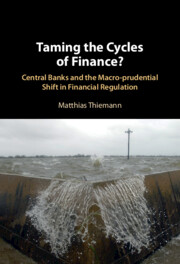Book contents
- Taming the Cycles of Finance?
- Taming the Cycles of Finance?
- Copyright page
- Contents
- Figures
- Tables
- Prologue
- Acknowledgments
- 1 Introduction
- 2 The Changing Regulation of Finance after the Crisis
- 3 The Evolution of Systemic Risk Thinking Pre-crisis
- 4 The Selective Rise of Macro-prudential Ideas in the Wake of the Crisis
- 5 Is Resilience Enough?
- 6 From the Global to the Local
- 7 Taming Liquidity and Leverage in the Shadow Banking Sector
- 8 Into the Upswing
- 9 The Crisis That Wasn’t
- 10 Conclusion
- Appendix: List of Interviews Conducted
- References
- Index
5 - Is Resilience Enough?
The Implementation of the Macro-Prudential Reform Agenda in the USA, the UK and the Eurozone
Published online by Cambridge University Press: 15 February 2024
- Taming the Cycles of Finance?
- Taming the Cycles of Finance?
- Copyright page
- Contents
- Figures
- Tables
- Prologue
- Acknowledgments
- 1 Introduction
- 2 The Changing Regulation of Finance after the Crisis
- 3 The Evolution of Systemic Risk Thinking Pre-crisis
- 4 The Selective Rise of Macro-prudential Ideas in the Wake of the Crisis
- 5 Is Resilience Enough?
- 6 From the Global to the Local
- 7 Taming Liquidity and Leverage in the Shadow Banking Sector
- 8 Into the Upswing
- 9 The Crisis That Wasn’t
- 10 Conclusion
- Appendix: List of Interviews Conducted
- References
- Index
Summary
Chapter 5 shows how reflexive central bank leaders sought to adapt the new policy paradigm in a way that was compatible with the institutional context. This involved both the political economy within which their central bank was embedded (both with respect to the way that central bank independence was installed and the industry relationships they had to entertain) and the way that central bank accountability was secured. I unearth a muted embrace of the new macro-prudential mandate, in particular the discretionary anti-cyclical part, owing to the lack of scientific legitimacy of these new ideas and the fear of politicization inherent in this new regulatory approach. Overall, I find that the bureaucratic work to adapt and operationalize the macro-prudential mandate led to a prioritization of the goal to increase the resilience of the system, whereas the anti-cyclical goal became a secondary element, although the studied countries differed in their emphasis on anti-cyclical action. Such anti-cyclical action exposed central banks to the risk of agonizing both political elites and the financial industry, making reflexive agency leaders shy away from its full enforcement.
- Type
- Chapter
- Information
- Taming the Cycles of Finance?Central Banks and the Macro-prudential Shift in Financial Regulation, pp. 103 - 131Publisher: Cambridge University PressPrint publication year: 2024



